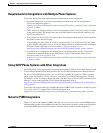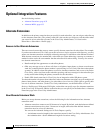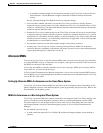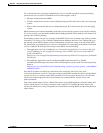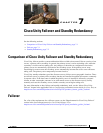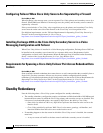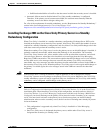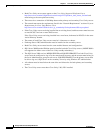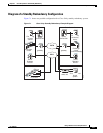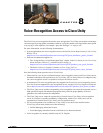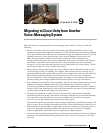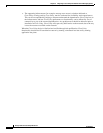
7-3
Design Guide for Cisco Unity Release 5.x
OL-14619-01
Chapter 7 Cisco Unity Failover and Standby Redundancy
Standby Redundancy
–
Sufficient bandwidth for call traffic to the data center in which the secondary server is installed.
• Automatic failover must be disabled when Cisco Unity standby redundancy is configured.
Therefore, if the primary server becomes unavailable, the customer must manually make the
secondary server active before it begins taking calls.
For a list of the requirements for standby redundancy, see the “Requirements for Standby Redundancy”
section in the System Requirements for Cisco
Unity Release 5.0 at
http://www.cisco.com/en/US/products/sw/voicesw/ps2237/prod_installation_guides_list.html.
Installing Exchange 2003 on the Cisco Unity Primary Server in a Standby
Redundancy Configuration
When Cisco Unity is installed in a standby redundancy configuration, Exchange Server 2003 can be
installed on the primary server instead of on a separate, third server. This reduces the number of servers
required for a standby redundancy configuration, and also allows Cisco
Unity and Exchange to be in the
same data center except when the secondary server is active.
When the secondary Cisco Unity server is active, the primary server, on which Exchange is installed, is
probably completely unavailable, which means that Exchange is also unavailable. The secondary
Cisco
Unity server answers calls, allows outside callers to look up subscriber extensions, and records
voice messages. However, subscribers who check their voice messages hear the Unity Messaging
Repository (UMR) conversation. This conversation explains that their Exchange server is not available,
and lets them access voice messages that were sent after the primary Cisco
Unity server became
unavailable. Any voice messages sent after the primary became unavailable are stored in the UMR on
the secondary Cisco
Unity server. When the primary Cisco Unity server is active again and Exchange on
the primary is available again, the voice messages stored in the UMR are routed to the subscriber
mailboxes.
Caution If the message store is already installed on a separate platform, do not reconfigure the existing
Cisco
Unity system to move Exchange to the primary Cisco Unity server. Otherwise, the Cisco Unity
standby redundancy system will not be supported. Only new installations of Cisco
Unity with standby
redundancy can be configured with Exchange on the primary server.
Note This configuration is not yet documented in System Requirements for Cisco Unity Release 5.0, in the
Failover Configuration and Administration Guide for Cisco
Unity Release 5.x, or in the Cisco Unity
installation guide. When installing Cisco
Unity in this configuration, use the Installation Guide for
Cisco
Unity Release 5.x in a Voice Messaging Configuration with Microsoft Exchange (With Failover
Configured), but install Exchange on the primary server instead of on the secondary or on a separate
server. You must install software on the primary server first because when you install Exchange
administration software on the secondary server, the full version of Exchange must already be present
in the environment.
• This configuration is supported only when Cisco Unity is installed in a Voice Messaging
configuration.
• One Cisco Unity server is designated the primary server, and the other Cisco Unity server is
designated the secondary (or standby) server.



